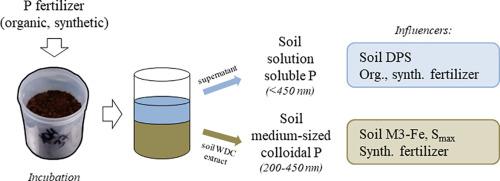Science of the Total Environment ( IF 8.2 ) Pub Date : 2020-09-01 , DOI: 10.1016/j.scitotenv.2020.142112 Maëlle Fresne , Phil Jordan , Owen Fenton , Per-Erik Mellander , Karen Daly

|
Colloid-facilitated transport can be important for preferential transfer of phosphorus (P) through the soil profile to groundwater and may in part explain elevated P concentrations in surface water during baseflow and particularly high flow conditions. To investigate the potential for colloidal P (Pcoll) mobilisation in soils, this study assessed the role of soil chemical properties and P fertilizer type on medium-sized soil Pcoll (200–450 nm) and its association with soil solution soluble bioavailable P (<450 nm). Hillslope soils from three agricultural catchments were sampled and untreated and treated (cattle slurry and synthetic fertilizer) subsamples were incubated. Soil supernatants were analysed for P and soil Water Dispersible Colloids (WDC) were extracted for analysis of P and P-binding materials. Soils physicochemical properties including degree of P saturation (DPS) and P sorption properties were determined. Results indicated that medium-sized Pcoll was mostly unreactive P associated to some extent to amorphous forms of Fe. Medium-sized Pcoll concentrations correlated negatively with soil maximum P sorption capacity and soluble P concentrations increased with increasing DPS. In soil with low sorption properties, cattle slurry increased soluble P concentrations by 0.008–0.013 mg l−1 and DPS but did not influence medium-sized Pcoll. Synthetic fertilizer increased medium-sized reactive Pcoll by 0.011 mg l−1 (0.088 mg kg−1 soil) and DPS in a soil with lower DPS whereas it decreased it by 0.005 mg l−1 (0.040 mg kg−1 soil) in a soil with higher DPS. Additional soil parameters (M3-Fe, M3-Al, M3-P, and DPS) should be included in soil testing, especially in Cambisol/Podzol soils, to identify critical areas where risks of Pcoll mobilisation are important. Further research should include the roles of finer colloidal and nanoparticulate (<200 nm) soil P fractions and soluble P to inform understanding of plant uptake and assess environmental risk.
中文翻译:

土壤化学和肥料对农业土壤可溶性和中等胶态磷的影响
胶体促进的运输对于优先通过土壤剖面将磷(P)转移至地下水很重要,并且可以部分解释基流特别是高流量条件下地表水中磷的浓度升高。为了研究胶态P(P coll)在土壤中的动员潜力,本研究评估了土壤化学性质和P肥料类型对中型土壤P coll的作用(200–450 nm)及其与土壤溶液中可溶性生物有效性P(<450 nm)的关联。对来自三个农业流域的坡地土壤进行采样,然后对其进行未经处理和经过处理的(牛粪和合成肥料)子样本进行培养。分析土壤上清液中的P,提取土壤水分散性胶体(WDC)以分析P和P结合物质。测定了土壤的理化特性,包括磷饱和度(DPS)和磷吸附特性。结果表明,中等大小的P coll在某种程度上与无定形形式的Fe相关,大部分是不活泼的P。中型P coll浓度与土壤最大磷吸收能力呈负相关,可溶性磷浓度随DPS的增加而增加。在低吸附性的土壤中,牛粪浆使可溶性P浓度增加0.008–0.013 mg l -1和DPS,但不影响中等大小的P coll。合成肥料在DPS较低的土壤中使中等水平的反应性P coll增加0.011 mg l -1(0.088 mg kg -1土壤)和DPS,而在其中降低了0.005 mg l -1(0.040 mg kg -1土壤)DPS较高的土壤中)。在土壤测试中,尤其是在Cambisol / Podzol土壤中,应包括其他土壤参数(M3-Fe,M3-Al,M3-P和DPS),以识别出重要的P Coll动员风险区域。进一步的研究应包括更细的胶体和纳米颗粒(<200 nm)土壤P组分和可溶性P的作用,以帮助人们理解植物吸收并评估环境风险。





















































 京公网安备 11010802027423号
京公网安备 11010802027423号